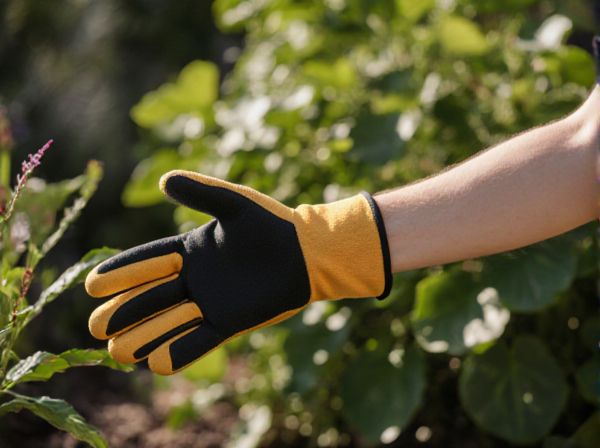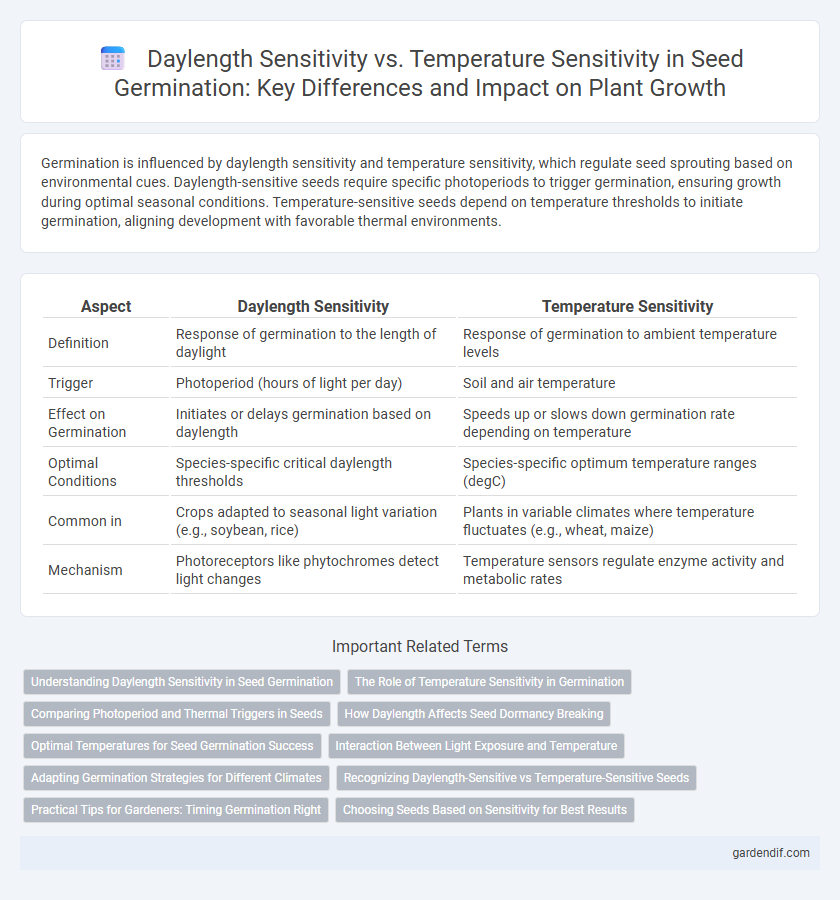
Daylength Sensitivity vs Temperature Sensitivity Illustration
Germination is influenced by daylength sensitivity and temperature sensitivity, which regulate seed sprouting based on environmental cues. Daylength-sensitive seeds require specific photoperiods to trigger germination, ensuring growth during optimal seasonal conditions. Temperature-sensitive seeds depend on temperature thresholds to initiate germination, aligning development with favorable thermal environments.
Table of Comparison
| Aspect | Daylength Sensitivity | Temperature Sensitivity |
|---|---|---|
| Definition | Response of germination to the length of daylight | Response of germination to ambient temperature levels |
| Trigger | Photoperiod (hours of light per day) | Soil and air temperature |
| Effect on Germination | Initiates or delays germination based on daylength | Speeds up or slows down germination rate depending on temperature |
| Optimal Conditions | Species-specific critical daylength thresholds | Species-specific optimum temperature ranges (degC) |
| Common in | Crops adapted to seasonal light variation (e.g., soybean, rice) | Plants in variable climates where temperature fluctuates (e.g., wheat, maize) |
| Mechanism | Photoreceptors like phytochromes detect light changes | Temperature sensors regulate enzyme activity and metabolic rates |
Understanding Daylength Sensitivity in Seed Germination
Daylength sensitivity in seed germination refers to the influence of photoperiod on the activation of enzymatic and hormonal pathways that regulate seed sprouting. Seeds exhibiting strong daylength sensitivity require specific light durations to initiate germination, often linked to phytochrome-mediated responses to red and far-red light. Understanding these mechanisms helps optimize planting schedules and improve germination rates by aligning seed exposure to optimal daylength conditions.
The Role of Temperature Sensitivity in Germination
Temperature sensitivity plays a crucial role in seed germination by regulating enzymatic activities and metabolic processes necessary for embryo development. Unlike daylength sensitivity, which depends on photoperiod cues, temperature sensitivity ensures seeds only germinate under optimal thermal conditions to maximize survival and growth. This adaptive mechanism allows seeds to respond dynamically to fluctuating temperatures, enhancing successful germination rates across diverse environmental contexts.
Comparing Photoperiod and Thermal Triggers in Seeds
Seed germination is influenced by daylength sensitivity, where photoperiod acts as a crucial environmental cue regulating the timing of sprouting, and temperature sensitivity, which depends on thermal thresholds determining enzymatic activity and metabolic rates. Photoperiodic response varies among species, with long-day, short-day, or day-neutral seeds interpreting light duration to initiate germination, while thermal cues involve base, optimum, and ceiling temperatures crucial for enzymatic processes during seed imbibition and radicle emergence. The interaction between photoperiod and temperature modulates seed dormancy breaking and germination synchrony, impacting agricultural scheduling and ecosystem phenology predictions.
How Daylength Affects Seed Dormancy Breaking
Daylength influences seed dormancy breaking by regulating hormonal changes that trigger germination, with longer photoperiods often promoting the synthesis of gibberellins essential for dormancy release. Seeds exposed to specific daylengths can perceive environmental cues that signal optimal conditions for growth, thereby synchronizing germination with favorable seasons. This photoperiodic sensitivity interacts with temperature cues but remains a distinct mechanism controlling the timing of seed germination.
Optimal Temperatures for Seed Germination Success
Optimal temperatures for seed germination differ significantly between daylength-sensitive and temperature-sensitive species, with temperature-sensitive seeds typically requiring a precise thermal range of 15-30degC to maximize germination rates. Daylength sensitivity influences germination indirectly by aligning the seed's readiness to environmental light cycles, often favoring species adapted to longer daylight periods, but temperature remains the central factor enabling enzymatic activity and cellular processes essential for germination. Understanding species-specific thermal thresholds enhances agricultural forecasting and improves seedling establishment success under varying climatic conditions.
Interaction Between Light Exposure and Temperature
Germination rates in many plant species are significantly influenced by the interaction between daylength sensitivity and temperature sensitivity, where specific photoperiods trigger hormonal changes that regulate seed dormancy and activation. Short-day or long-day conditions can modulate temperature thresholds required for optimal enzyme activity during germination, affecting metabolic rates and seedling vigor. Understanding this interaction helps optimize controlled environment agriculture by aligning light exposure and temperature regimes to maximize germination efficiency and uniformity.
Adapting Germination Strategies for Different Climates
Daylength sensitivity regulates seed germination by triggering physiological responses to specific photoperiods, optimizing growth in regions with distinct seasonal light variations. Temperature sensitivity influences enzymatic activities and hormone levels that govern germination timing, crucial for survival in climates with fluctuating thermal conditions. Integrating both sensitivities enables plants to adapt germination strategies, aligning seedling emergence with favorable environmental windows across diverse climatic zones.
Recognizing Daylength-Sensitive vs Temperature-Sensitive Seeds
Daylength-sensitive seeds require specific photoperiods to initiate germination, often germinating when daylight reaches a critical length, while temperature-sensitive seeds respond primarily to temperature thresholds, germinating only when ambient temperatures fall within an optimal range. Recognizing daylength-sensitive seeds involves monitoring light exposure patterns, whereas temperature-sensitive seeds necessitate temperature-controlled environments to trigger germination. Understanding these sensitivities is crucial for optimizing germination rates in agricultural and horticultural practices.
Practical Tips for Gardeners: Timing Germination Right
Gardeners should monitor daylength and temperature closely, as daylength sensitivity affects photoperiod-responsive seeds that germinate optimally under specific light durations, while temperature sensitivity influences seeds requiring certain thermal conditions. To time germination successfully, use soil thermometers to ensure temperatures reach seed-specific thresholds and track daylight hours to align planting with optimal photoperiod windows. Combining temperature data with local sunrise and sunset information helps prevent premature or delayed germination, enhancing seedling vigor and growth outcomes.
Choosing Seeds Based on Sensitivity for Best Results
Selecting seeds based on daylength sensitivity ensures optimal germination in regions where photoperiod significantly influences plant development, maximizing growth efficiency. Temperature sensitivity is crucial for seeds in climates with variable thermal conditions, as proper temperature ranges trigger successful germination and seedling vigor. Combining knowledge of both daylength and temperature sensitivities enables growers to tailor seed choices to local environmental factors, enhancing crop yields and resilience.
Daylength Sensitivity vs Temperature Sensitivity Infographic

 gardendif.com
gardendif.com